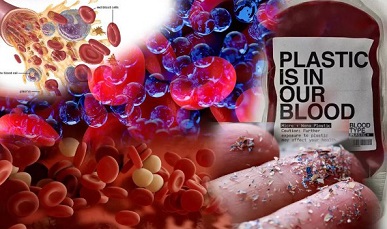Nikhil Prasad Fact checked by:Thailand Medical News Team May 16, 2024 1 year, 7 months, 2 weeks, 19 hours, 34 minutes ago
Medical News: Recent research has uncovered the presence of microplastics in human blood, posing new and potentially serious health risks. The study covered in this
Medical News report found traces of various microplastic polymers, highlighting the growing concern over their potential impact on human health, particularly cardiovascular health.
 Microplastics Found In Human Blood - A New Health Threat!
Microplastics Found In Human Blood - A New Health Threat!
Microplastics, tiny synthetic plastic particles, are ubiquitous in our environment. They are found in air, water, soil, and throughout the food chain. These particles can enter the human body primarily through inhalation and ingestion. Recent evidence has shown that microplastics can be found in various human tissues and organs, including the lungs, colon, liver, placenta, breast milk, veins, and testis. The discovery of microplastics in human blood adds a new layer of concern regarding their potential health impacts.
The Study and Its Findings
In a study conducted to explore the presence of microplastics in human blood, scientists from the University of Hull-United Kingdom used the micro-Fourier Transform Interferometer (μFTIR) microscopy technique to identify the types, sizes, and shapes of microplastic polymers in blood samples. Twenty healthy individuals participated in the study, and the results were alarming.
Blood samples collected from the participants revealed the presence of 24 different polymer types in 90% of the participants. When applying the Limit of Quantitation (LOQ) threshold, microplastics were detected in 40% of the participants. The study identified five polymer types above the LOQ threshold: polyethylene (PE), ethylene propylene diene monomer (EPDM), ethylene-vinyl acetate/ethylene vinyl alcohol (EVA/EVOH), polyamide (PA), and ethylene-vinyl acetate (EVA).
Important Observations
The study found that the concentration and variety of polymer types varied among the samples. Up to three different polymer types were identified in a single sample. The most widely detected polymer was PE, followed by EVA/EVOH, EPDM, PA, and EVA. The highest concentrations of these polymers in a single sample were as follows:
PE: 4.65 µg/mL
EVA/EVOH: 1.84 µg/mL
EPDM: 2.22 µg/mL
PA: 1.84 µg/mL
EVA: 0.61 µg/mL
Characterization of Microplastic Polymers
The study found that PE, EVA/EVOH, and EPDM were the most abundant polymer types, accounting for more than 50% of all identified polymers. The average length and width of the identified microplastic particles were 127.99 ± 293.26 µm and 57.88 ± 88.89 µm, respectively. About 88% of the microplastics were categorized as fragments, with 79% being white or clear in appearance. The study also identified several additive chemicals or plastic alternatives in the microplastic polymers, including phthalates, which were detected in 20% of the blood samples.
Potential Health Impacts
t;
The presence of microplastics in human blood raises significant health concerns. The size and shape of these particles can determine their potential health hazards, which may include inflammation, oxidative stress, barrier disruption, genetic instability, reproductive complications, developmental and endocrine disorders, blood clot formation, and cardiovascular complications.
Microplastic particles identified in this study were larger and had different shapes than those previously identified. Their high flexibility might allow them to enter small-diameter blood capillaries, potentially slowing their transit and facilitating longer interactions with blood proteins. This interaction can lead to the formation of a corona, which prevents the immune system from recognizing the microplastics, thereby increasing their duration of exposure within the body.
Non-linear microplastic particles could get stuck in capillaries, impairing blood flow and altering local oxygen concentrations, which could collectively affect cell metabolism and function. The findings highlight the need for future studies to investigate the potential toxic effects of microplastics on human health.
Study Significance
This study is significant as it identifies 24 different polymer types of microplastics in human blood samples. The most abundant polymers were polyethylene, ethylene propylene diene, and ethylene-vinyl-acetate/alcohol. Polyethylene is commonly used in packaging film, bags, bottles, toys, wire and cable insulation, and many household items. It is also used in medical implants and has previously been detected in human lung tissues and breast milk. Ethylene propylene diene is used in the automotive industry and artificial turfs, while ethylene-vinyl-acetate/alcohol is used in food packaging, agricultural film, and the automotive industry.
The study's findings suggest that microplastics with larger sizes and different shapes than previously identified could potentially have more severe health impacts. These particles may be more likely to enter and remain in the bloodstream, leading to prolonged exposure and interaction with the body's systems.
Conclusion
The presence of microplastics in human blood is a concerning discovery, with potential implications for human health, particularly cardiovascular health. The study highlights the urgent need for further research to understand the full extent of these health risks and to develop strategies to mitigate exposure to microplastics. As microplastics continue to permeate our environment and bodies, addressing this emerging health threat becomes increasingly critical.
The study findings were published in the peer reviewed journal: Environment International.
https://www.sciencedirect.com/science/article/pii/S0160412024003374
For the latest
Medical News, keep on logging to Thailand Medical News.
